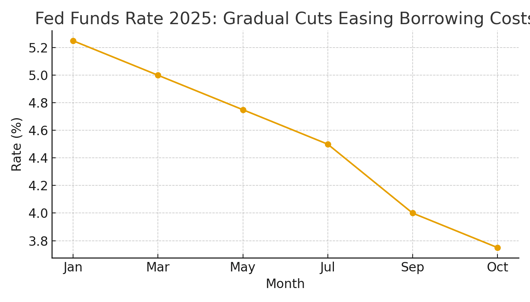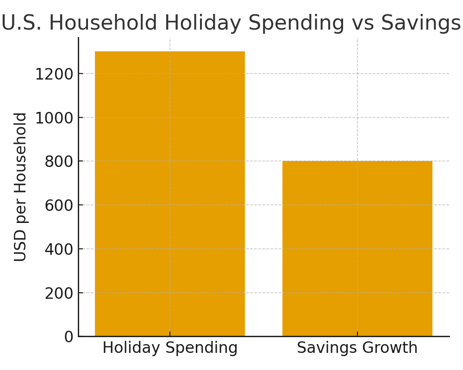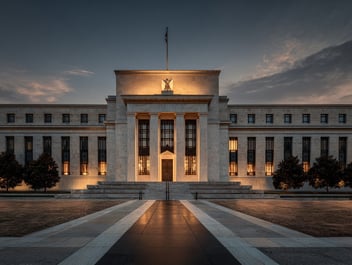
Lower Interest Rates Don’t Mean Free Spending: How to Use the Fed’s 2025 Rate Cuts to Win Your Holiday Budget and 2026 Money Plan
After two years of high borrowing costs, Americans finally got a little relief. In late October 2025, the Federal Reserve cut interest rates again—bringing the target range down to 3.75 to 4 percent. Mortgage rates have inched lower, auto loans are stabilizing, and savings account yields, while still elevated by historic standards, are starting to decline.
It’s a welcome change for many households heading into the holidays. But lower rates can also create a false sense of comfort. When money feels “cheaper,” we’re more likely to swipe a little more, book that trip, or stretch our holiday budget past what we planned. The truth is, rate cuts don’t immediately make life cheaper—they simply shift the landscape of how debt and savings behave.
This guide explains what the Fed’s 2025 rate cuts actually mean for your day-to-day finances, how to use this window to reset before 2026, and how to build a holiday plan that keeps you in control—not in credit card debt.
Why the Fed Cut Rates—and What It Means for You
The Federal Reserve uses rate cuts as a lever to keep the economy balanced. When inflation cools and growth slows, the Fed lowers borrowing costs to encourage investment and consumer spending. This latest move signals confidence that inflation is under control—but also concern that growth may be slowing faster than desired.
Here’s what that means for everyday Americans:
- Borrowing may become slightly cheaper—but not instantly. Credit card APRs, personal loans, and auto loans may drop by 0.25 to 0.50 points over the next few months. Mortgages could ease a bit faster if bond markets remain stable.
- Savings yields are likely to fall—banks adjust quickly when the Fed lowers rates. The 5 percent online savings account you opened in early 2025 could be 4.5 percent or less by early 2026.
- Investment markets may react positively—lower rates can lift stock valuations, though volatility remains high. Conservative savers, however, might see their guaranteed returns fade.
In short: lower rates shift the balance between borrowers and savers. If you carry high-interest debt, this is a moment to get ahead. If you rely on interest income, it’s time to protect and plan.
What Rate Cuts Don’t Do
Many Americans misunderstand rate cuts as an automatic “discount” on all financial obligations. But several misconceptions persist:
- They don’t erase existing debt. Your credit card balance at 22 percent APR won’t suddenly drop. It might fall to 21.5 percent—but only if your lender passes through savings (many don’t).
- They don’t make overspending safe. If you rack up an extra $1,000 in December gifts, a lower interest rate saves you only a few dollars a month. What matters most is avoiding the debt in the first place.
- They don’t protect your savings rate. Most banks move quickly to cut deposit yields. If you’re earning interest on cash, be proactive now.
The bottom line: rate cuts can help if you act intentionally. Without a plan, they simply shift where you lose and gain.
Step 1: Audit Your Year-End Finances
Before you react to any news, take stock. The last 60 days of the year are the perfect time to understand your full financial picture. Use your Bountisphere Money Calendar to review:
- Debt balances – List all credit cards, auto loans, personal loans, and mortgages. Note the interest rate and minimum payment for each.
- Cash reserves – Check how much you have in checking, savings, and emergency funds.
- Upcoming expenses – Gifts, travel, property taxes, insurance renewals, and any large December bills.
- Planned income – Holiday bonuses, side income, reimbursements, or any year-end payouts.
This audit sets the stage for better decisions. If you see that January will bring a dip in income or a spike in bills, you can adjust spending now—before it becomes a problem.
Step 2: Create a “Rate-Aware” Holiday Budget
The psychological trap of rate cuts is feeling richer when we’re not. Behavioral economists call this money illusion—the tendency to confuse lower rates with higher purchasing power.
To avoid it, frame your holiday budget around actual cash flow rather than perceived affordability. A simple structure works best:
- Essential expenses: Rent/mortgage, utilities, insurance, and groceries. These are non-negotiable.
- Planned savings or debt payoff: Continue your regular transfers—even during the holidays.
- Holiday spending: Whatever’s left after the first two categories is your true discretionary pool.
If you use Bountisphere, visualize this directly in your Money Calendar. Plot each upcoming expense and gift purchase to see your projected balance. If your running total ever drops below $100, treat it as a red alert. That’s the power of foresight—seeing problems before they happen.
Step 3: Leverage Lower Rates Wisely
Lower interest rates can open a few windows of opportunity—if you act deliberately. Here’s how to make the most of them:
1. Refinance or Consolidate High-Interest Debt
Credit card APRs have hovered above 20 percent for much of 2024 – 2025. If your credit score has improved, explore personal loan offers or 0 percent balance-transfer promotions. Even a modest rate cut can translate into hundreds of dollars saved annually.
2. Check Auto or Home Equity Rates
If you bought a car or tapped home equity when rates were near 7 percent, you may now qualify for a better deal. Run the numbers—but be mindful of fees and reset timelines. Refinancing only makes sense if you’ll keep the loan long enough to benefit.
3. Reevaluate Savings Accounts
Those 5 percent high-yield accounts are trending toward 4 percent or lower. Don’t chase every new offer, but check if your bank’s rate has quietly slipped. A difference of 0.5 points on a $20,000 balance equals $100 per year—worth noticing.
4. Prepare for Lower CD Rates
If you rely on certificates of deposit for short-term savings, consider locking in a rate now. The next 6 to 12 months could bring gradual declines.
5. Maintain Perspective
Don’t confuse small financial tweaks with structural change. The biggest driver of your financial health is behaviour—consistent saving, mindful spending, and planning ahead.
Step 4: Avoid the Holiday Money Fog
In a previous Bountisphere post, we explored the concept of money fog—the emotional haze that blurs our financial awareness. The holidays are a perfect storm for it: emotion-driven purchases, social pressure, and endless “limited-time” offers.
This year, make awareness your advantage. Before any big purchase, pause and ask three quick questions:
- Is this aligned with my Money Plan? If it’s not on the plan, add it first—seeing it in context often changes your decision.
- Will this affect my January balance? Overspending now often means pain later.
- What emotion am I trying to satisfy? Generosity, guilt, or the thrill of buying can all drive spending that doesn’t match our values.
That brief pause can save you from the fog—and from financial hangovers in January.
Step 5: Use the “Surplus Redirect” Technique
Here’s where behaviour meets opportunity. If lower interest rates reduce your monthly loan payments—or if you find yourself under budget for holiday gifts—don’t let the surplus sit idle. Redirect it purposefully.
Try this simple rule:
- 50 percent toward paying down the highest-interest debt
- 30 percent toward your emergency or savings account
- 20 percent toward something joyful or meaningful
Even $100 reallocated this way creates momentum. The key is to do it automatically—before the money disappears into daily spending.
Step 6: Prepare for 2026—Your Year of Financial Calm
As 2025 ends, remember: rate cuts are not the story. Your response to them is.
Use this moment to design a calmer, more predictable financial year ahead:
- Update your Money Plan with realistic 2026 goals—debt reduction, savings, or investment targets.
- Build “buffer months” in your Money Calendar—months where you intentionally spend below average to rebuild reserves.
- Automate your best habits. The less you rely on willpower, the more consistent your results.
- Stay rate-aware. Future cuts could continue through 2026. Use them to strengthen, not loosen, your discipline.
Visualizing the Change
Here’s a simple chart you could include to illustrate the impact of recent rate changes:

And another chart for household impact:
Quick Reference: 2025 Year-End Money Checklist
- ✅ Review all loan and credit card rates.
- ✅ Compare savings yields and lock in certificates before further cuts.
- ✅ Set a holiday budget based on actual disposable income.
- ✅ Plan January 2026 bills now to avoid New-Year surprises.
- ✅ Use Bountisphere’s Money Calendar to visualize cash flow through February.
- ✅ Redirect any “found” savings to your highest-priority goal.
Mindset Matters: A Note on Gratitude and Choice
Thanksgiving and the holiday season naturally bring reflection. This year, gratitude can be more than emotion—it can be strategy. Gratitude shifts focus from what we lack to what we value. When you spend with gratitude, you’re less likely to chase meaning through money.
Ask yourself: “What purchases this season genuinely add joy or connection?” Everything else can wait.
Key Takeaways
- The Fed’s 2025 rate cuts offer opportunity, not a free pass. Use them to strengthen—not loosen—your financial habits.
- Lower rates help borrowers only if they pair with responsible behaviour. Savers must stay alert as yields fall.
- Your best end-of-year move: create a clear Money Calendar and redirect surplus funds toward meaningful goals.
- Financial calm in 2026 starts with clarity in November 2025.
Meta Information (for SEO)
Meta Title: How to Use the Fed’s 2025 Rate Cut to Win Your Holiday Budget and 2026 Money Plan
Meta Description: Discover how the Fed’s 2025 rate cuts affect your debt, savings, and holiday spending—plus a 60-day plan to finish the year strong and start 2026 right.
Keywords: Fed rate cut 2025, interest rates November 2025, holiday budgeting, end-of-year money plan, personal finance, Bountisphere
Final Thought
Rate cuts are headlines. Behavioral change is transformation. The smartest households in 2026 won’t be the ones who guessed where interest rates would go—they’ll be the ones who built systems to adapt calmly, consistently, and confidently.
Ready to start? Log in to your Bountisphere account and create your Money Calendar today. Make 2026 your year of financial calm.
%20512x512%20google%20store%20app%20logo%20SEPT%2024%2c%202025%20(4)-png.png?width=51&height=51&name=USE!!%20)%20512x512%20google%20store%20app%20logo%20SEPT%2024%2c%202025%20(4)-png.png)



